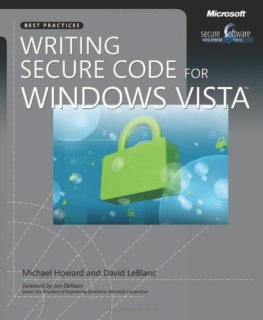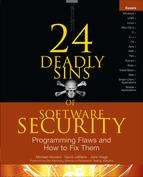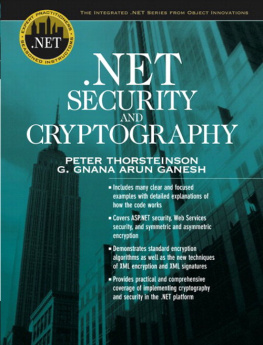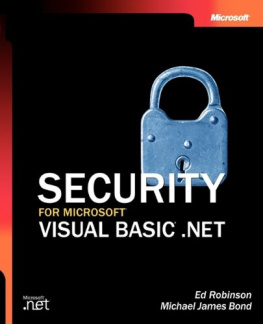
Copyright 2003 by Microsoft Corporation
PUBLISHED BYMicrosoft PressA Division of Microsoft CorporationOne Microsoft WayRedmond, Washington 98052-6399Copyright 2003 by Microsoft CorporationAll rights reserved. No part of the contents of this book may be reproduced or transmitted in any form orby any means without the written permission of the publisher.Library of Congress Cataloging-in-Publication DataHoward, Michael, 1965- Writing Secure Code / Michael Howard, David LeBlanc.--2nd ed. p. cm. Includes index. ISBN 0-7356-1722-8 1. Computer security. 2. Data encryption (Computer science). I. LeBlanc, David, 1960- II. Title.QA76.9.A25 H698 2002b005.8--dc21 2002035986Printed and bound in the United States of America.1 2 3 4 5 6 7 8 9 QWT 8 7 6 5 4 3Distributed in Canada by H.B. Fenn and Company Ltd.A CIP catalogue record for this book is available from the British Library.Microsoft Press books are available through booksellers and distributors worldwide. For further informationabout international editions, contact your local Microsoft Corporation office or contact MicrosoftPress International directly at fax (425) 936-7329. Visit our Web site at www.microsoft.com/mspress. Sendcomments to mspinput@microsoft.com.Active Directory, ActiveX, Authenticode, Hotmail, JScript, Microsoft, Microsoft Press, MSDN, MS-DOS,Visual Basic, Visual C++, Visual Studio, Win32, Windows, and Windows NT are either registeredtrademarks or trademarks of Microsoft Corporation in the United States and/or other countries. Otherproduct and company names mentioned herein may be the trademarks of their respective owners.The example companies, organizations, products, domain names, e-mail addresses, logos, people,places, and events depicted herein are fictitious. No association with any real company, organization,product, domain name, e-mail address, logo, person, place, or event is intended or should beinferred.Acquisitions Editor: Danielle BirdProject Editor: Devon MusgraveTechnical Editor: Brian JohnsonBody Part No. X08-92500
For Cheryl and Blake, the two most beautiful people I know.
Michael
To Jennifer, for putting up with still more lost weekends when we should havebeen out riding together.
David
Introduction
During February and March of 2002, all normal feature work on Microsoft Windows stopped. Throughout this period, the entire development team turned its attention to improving the security of the next version of the product, Windows .NET Server 2003. The goal of the Windows Security Push, as it became known, was to educate the entire team about the latest secure coding techniques, to find design and code flaws, and to improve test code and documentation. The first edition of this book was required reading by all members of the Windows team during the push, and this second edition documents many of the findings from that push and subsequent security pushes for other Microsoft products, including SQL Server, Office, Exchange, Systems Management Server, Visual Studio .NET, the .NET common language runtime, and many others.
The impetus for the Windows Security Push (and many of the other security pushes) was Bill Gates's Trustworthy Computing memo of January 15, 2002, which outlined a high-level strategy to deliver a new breed of computer systems, systems that are more secure and available. Since the memo, both of us have spoken to or worked with thousands of developers within and outside Microsoft, and they've all told us the same thing: We want to do the right thingwe want to build secure softwarebut we don't know enough yet. That desire and uncertainty directly relates to this book's purpose: to teach people things they were never taught in schoolhow to design, build, test, and document secure software. By secure software , we don't mean security code or code that implements security features. We mean code that is designed to withstand attack by malicious attackers. Secure code is also robust code.
Our goal for this book is to be relentlessly practical. A side effect is to make you understand that your code will be attacked. We can't be more blunt, so let us say it again. If you create an application that runs on one or more computers connected to a network or the biggest network of them all, the Internet, your code will be attacked.
The consequences of compromised systems are many and varied, including loss of production, loss of customer faith, and loss of money. For example, if an attacker can compromise your application, such as by making it unavailable, your clients might go elsewhere. Most people have a low wait-time threshold when using Internet-based services. If the service is not available, many will take their patronage and money to your competitors.
The real problem with numerous software development houses is that security is not seen as a revenue-generating function of the development process. Because of this, management does not want to spend money training developers to write secure code. Management does spend money on security technologies, but that's usually after a successful attack! And at that point, it's too latethe damage has been done. Fixing applications post-attack is expensive, both financially and in terms of your reputation.
Protecting property from theft and attack has been a time-proven practice. Our earliest ancestors had laws punishing those who chose to steal, damage, or trespass on property owned by citizens. Simply, people understand that certain chattels and property are private and should stay that way. The same ethics apply to the digital world, and therefore part of our job as developers is to create applications and solutions that protect digital assets.
You'll notice that this book covers some of the fundamental issues that should be covered in school when designing and building secure systems is the subject. You might be thinking that designing is the realm of the architect or program manager, and it is, but as developers and testers you need to also understand the processes involved in outlining systems designed to withstand attack.
We know software will always have vulnerabilities, regardless of how much time and effort you spend trying to develop secure software, simply because you cannot predict future security research. We know this is true of Microsoft Windows .NET Server 2003, but we also know you can reduce the overall number of vulnerabilities and make it substantially harder to find and exploit vulnerabilities in your code by following the advice in this book.
Who Should Read This Book
If you design applications, or if you build, test, or document solutions, you need this book. If your applications are Web-based or Win32-based, you need this book. Finally, if you are currently learning or building Microsoft .NET Frameworkbased applications, you need this book. In short, if you are involved in building applications, you will find much to learn in this book.
Even if you're writing code that doesn't run on a Microsoft platform, much of the material in this book is still useful. Except for a few chapters that are entirely Microsoft-specific, the same types of problems tend to occur regardless of platform. Even when something might seem to be applicable only to Windows, it often has broader application. For example, an Everyone Full Control access control list and a file set to World Writable on a UNIX system are really the same problem, and cross-site scripting issues are universal.
Organization of This Book
The book is divided into five parts. Chapters 1 through 4 make up Part I, Contemporary Security, and outline the reasons why systems should be secured from attack and guidelines and analysis techniques for designing such systems.

















